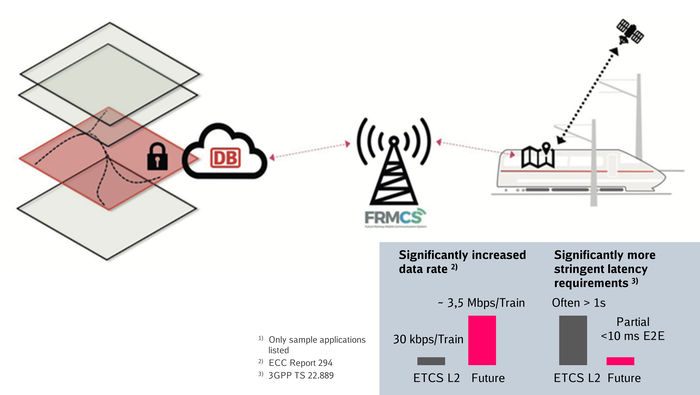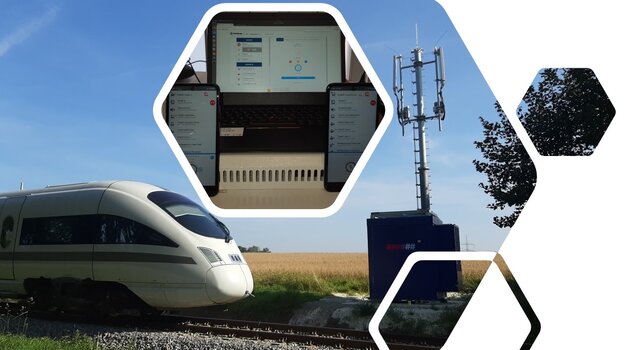FRMCS/5G Data Communication
The Future Railway Mobile Communication System (FRMCS), based on the 5G mobile communications standard, provides the necessary connectivity for future digital technologies.
Forward-looking, digital railway operations require a high-performance wireless connection for robust, real-time transmission with high bandwidth between trains and tracks. This requires a modern mobile communications network based on the new 5G mobile communications standard.
The 2G-based GSM-R mobile communications standard from the 1990s currently used in the railway system is robust and secure, but it is not designed for the railway technologies of the future. In addition, this standard will be replaced in the coming years due to obsolescence. The so-called “Future Railway Mobile Communication System” (FRMCS), based on 5G technology, will be used in the future for a digital railway infrastructure throughout the entire route network.
FRMCS will support existing railway voice applications such as point-to-point calls, group calls, and the Railway Emergency Call (REC), as well as data services such as the European Train Control System (ETCS) and automated train operation (ATO).

The advantages of FRMCS at a glance
FRMCS meets high standards for future transmission rates, latency, availability, and encryption. The design of FRMCS follows two important guidelines: firstly, the decoupling of the communication platform from railway-specific applications and, secondly, the use of standardized, commercially available components wherever possible. The first aspect ensures that, even if the platform and application have different life cycles, both sides can be updated largely independently of each other. The second aspect enables cost-efficient FRMCS equipment on the train and infrastructure side, as standard components from industry are used that are also used in other sectors.
The technology in use
DB InfraGO and DB Erzgebirgsbahn have set up a mobile communications base infrastructure on a test track around ten kilometers long in the “Digitales Testfeld Bahn” in the Ore Mountains. This demonstrates how the integration and validation of digital railway system applications based on FRMCS/5G and cloud technology works in practice and how the new technology can be rolled out across a wide area. The FRMCS test environment is used for development collaborations with industry and for numerous research projects, such as the EU projects “5G-RAIL” and “FP2-MORANE-2” as well as the German-French innovation project “5G-RACOM.”
In order to gain practical experience with FRMCS and 5G, DB joined forces with Siemens, S-Bahn Hamburg, and Nokia in 2018 in the Digital S-Bahn Hamburg project to demonstrate how fully automated shunting operations (GoA4) can be implemented via 5G. In this setup, which is one of the world's first 5G standalone implementations, safety-critical information was exchanged between the train and infrastructure in real time during a fully automated return trip. This was demonstrated at the ITS World Congress 2021.
The flagship project FP2-MORANE-2 (Mobile radio for Railway Networks in Europe 2), funded by the EU under the Europe's Rail program, runs from December 2024 to September 2027 and aims to establish, verify, and complete the technical foundations for further specifying FRMCS, as well as enabling early pilot projects and validation activities. For example, it will test voice applications, data applications such as ETCS, ATO, and TCMS, as well as services like location and positioning, time stamping, and interoperability. Field tests will take place in four European countries. One of the test sites is the Erzgebirge test track, managed by DB InfraGO.
The German-French project 5G-RACOM, running from December 2022 to November 2025, tests innovative approaches for the new railway radio standard. It investigates hybrid FRMCS networks, where the public mobile network complements the railway-specific radio network – for example, as a fallback option or to increase capacity. This utilizes multipath protocols. These protocols select the best transmission path in both the railway and public mobile networks, ensuring seamless operation between the networks and enabling high reliability.
In the completed project 5GRAIL (5G for future Railway mobile communication system), funded by the EU under the Horizon 2020 program, initial prototypes for trains and infrastructure were developed, and a pre-validation of the first FRMCS/5G specifications was carried out.
Further Links
Please note that we are constantly writing articles in cooperation with trade magazins, which are unfortunately only published in German. Therefore you can only find publications in german.
- Article in "Signal+Draht" | MORANE-2: Der finale Validierungsschritt für FRMCS Edition 1 | 05/2025
- Article in "Signal+Draht" | Erste FRMCS/5G-Testumgebung in Deutschland für das Bahnsystem aufgebaut | 06/2023
- Articel in "Signal+Draht" | Innovative Antennentechnologien für FRMCS - Feldstudie bei 1,9 GHz | 11/2022
- Articel in "Signal+Draht" | 5G für das digitalisierte Bahnsystem der Zukunft – ein Ausblick auf FRMCS | 03/2022
Publications and technical articles on the topic of 5G/FRMCS can also be found in our download area.

